Development of Virtual Air Flow Sensor Using In-Situ Damper Performance Curve in VAV Terminal Unit
Abstract
1. Introduction
1.1. VAV Terminal Unit and Volume Damper
1.2. Typical Airflow Measurement of the VAV Terminal Unit
2. Methodology
2.1. Virtual Air Flow Sensor of VAV Terminal Unit
2.2. In-Situ Measurement Procedure
2.3. Error Analysis
3. Experimental Verification
3.1. Experimental Setup
3.2. Implementation of In-Situ Measurement Procedure
3.3. Verification of VAV Virtual Air Flow Sensor
4. Conclusions and Discussion
Author Contributions
Acknowledgments
Conflicts of Interest
Nomenclature
| Damper authority | |
| Pressure (pa) | |
| Air flow rate (m3/h) | |
| Fan speed ratio | |
| Damper opening ratio | |
| Pressure ratio | |
| Coefficient of in-situ damper performance curve | |
| Coefficient of damper opening ration-pressure ratio curve | |
| Coefficient of fan speed ratio-maximum differential pressure curve | |
| Relative error | |
| Subscripts | |
| differential pressure | |
| full speed | |
| partial speed | |
| max | Maximum |
| vir | virtual |
| meas | measurement |
References
- ASHRAE. ASHRAE Handbook 2015 Application: Design and Application of Controls; ASHRAE: Atlanta, GA, USA, 2015.
- Kang, S.; Kim, H.; Cho, Y. A Study on the control method of single duct VAV terminal unit through the determination of proper minimum air flow. Energy Build. 2014, 69, 464–472. [Google Scholar] [CrossRef]
- Cho, Y.-H.; Liu, M. Minimum airflow reset of single duct VAV terminal boxes. Build. Environ. 2009, 44, 1876–1885. [Google Scholar] [CrossRef]
- Kim, H.; Cho, Y. A Study on a Control Method with a Ventilation Requirement of a VAV System in Multi-zone. Sustainability 2017, 9, 2066. [Google Scholar] [CrossRef]
- Paliaga, G.; Zhang, H.; Hoyt, T.; Arens, E. Eliminating Overcooling Discomfort While Saving Energy. ASHRAE J. 2019, 61, 14–28. [Google Scholar]
- Liu, G.; Liu, M. Development of simplified in-situ fan curve measurement method using the manufacturers fan curve. Build. Environ. 2012, 48, 77–83. [Google Scholar] [CrossRef]
- Klopfenstein, R. Air velocity and flow measurement using a pitot tube. ISA Trans. 1998, 37, 257–263. [Google Scholar] [CrossRef]
- Schwenk, D. Air Flow Measurement Accuracy, US Army Corps of Engineers, Construction Engineering Research Laboratories; Conference Proceedings; HQUSACE: Washington, DC, USA, 1998. [Google Scholar]
- Liu, R.; Wen, J.; Waring, M. Improving airflow measurement accuracy in VAV terminal units using flow conditioners. Build. Environ. 2014, 71, 81–94. [Google Scholar] [CrossRef]
- Kim, H.; Kang, S.; Cho, Y. A study on the control method without stratification of single duct VAV terminal units. J. Asian Archit. Build. Eng. 2015, 14, 467–474. [Google Scholar] [CrossRef]
- ASHRAE. ASHRAE Handbook 2017 Fundamentals: Fundamentals of Controls; ASHRAE: Atlanta, GA, USA, 2017.
- ASHRAE. Dampers and Airflow Control; ASHRAE: Atlanta, GA, USA, 2009.
- Zhang, B.; Li, Y.; Lau, J.; Liu, M. Demand control ventilation: Influence of terminal box minimum airflow setting on system energy use. Energy Build. 2014, 79, 173–183. [Google Scholar] [CrossRef]
- Zhang, J.; Lutes, R.G.; Liu, G.; Brambley, M.R. Energy Savings for Occupancy-Based Control of Variable Air Volume Systems (PNNL-22072); Pacific Northwest National Laboratory: Richland, WA, USA, 2013. [Google Scholar]
- Papadopoulos, S.; Kontokosta, C.E.; Vlachokostas, A.; Azar, E. Rethinking HVAC temperature setpoints in commercial buildings: The potential for zero-cost energy savings and comfort improvement in different climates. Build. Environ. 2019, 115, 350–359. [Google Scholar] [CrossRef]
- Kim, W.; Katipamula, S. A review of fault detection and diagnostics methods for building systems. Sci. Technol. Built Environ. 2018, 24, 3–21. [Google Scholar] [CrossRef]
- Deshmukh, S.; Samouhos, S.; Glicksman, L.; Norford, L. Fault detection in commercial building VAV AHU: A case study of an academic building. Energy Build. 2019, 201, 163–173. [Google Scholar] [CrossRef]
- Deshmukh, S.; Glicksman, L.; Norford, L. Case study results: Fault detection in air-handling units in buildings. Adv. Build. Energy Res. 2018, 1–17. [Google Scholar] [CrossRef]
- Li., H.; Yu, D.; Braun, J. A review of virtual sensing technology and application in building systems. HVAC&R Res. 2011, 17, 619–648. [Google Scholar]
- Swamy, S.; Song, L.; Wang, G. A Virtual Chilled-Water Flow Meter Development at Air Handling Unit Level. ASHRAE Trans. 2012, 118, 1013–1020. [Google Scholar]
- Song, L.; Joo, I.; Wang, G. Uncertainty analysis of a virtual water flow measurement in building energy consumption monitoring. HVAC&R Res. 2012, 18, 997–1010. [Google Scholar]
- Wichman, A.; Braun, J. A Smart Mixed-Air Temperature Sensor. HVAC&R Res. 2009, 15, 101–115. [Google Scholar]
- Liu, M.; Liu, G.; Joo, I.; Song, L.; Wang, G. Development of in situ fan curve measurement for VAV AHU systems. J. Sol. Energy Eng. 2005, 127, 287–293. [Google Scholar] [CrossRef]
- Wang, G.; Liu, M. Development of power-head based fan aiflow station. In Proceedings of the 5th International Conference for Enhanced Building Operations, Pittsburgh, PA, USA, 11–13 October 2005. [Google Scholar]
- Yu, D.; Li, H.; Yang, M. A virtual supply airflow rate meter for rooftop air-conditioning units. Build. Environ. 2011, 46, 1292–1302. [Google Scholar] [CrossRef]
- Taylor, J.R. An Introduction to Error Analysis: The Study of Uncertainties in Physical Measurements, 2nd ed.; University Science Books: Sausalito, CA, USA, 1997. [Google Scholar]
- Shin, J.; Kim, Y.; Cho, Y. Development of operating method of multi-geothermal heat pump system using variable water flow rate control and a cop prediction model based on ANN. Energies 2019, 12, 3894. [Google Scholar] [CrossRef]
- ASTM. ASTM D3463-96 Standard Test Method for Average Velocity in a Duct Using a Thermal Anemometer; ASTM: West Conshohocken, PA, USA, 2014.

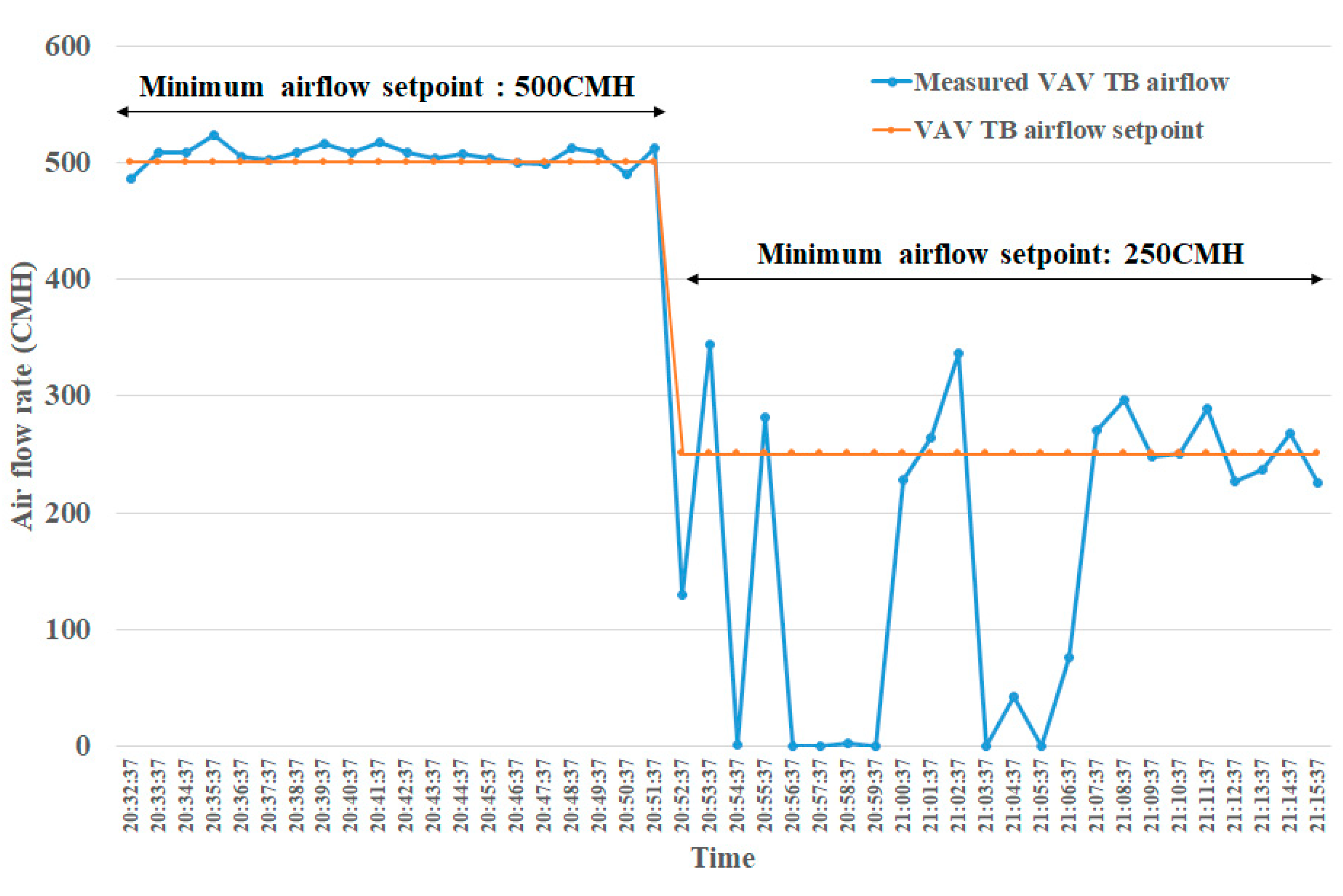
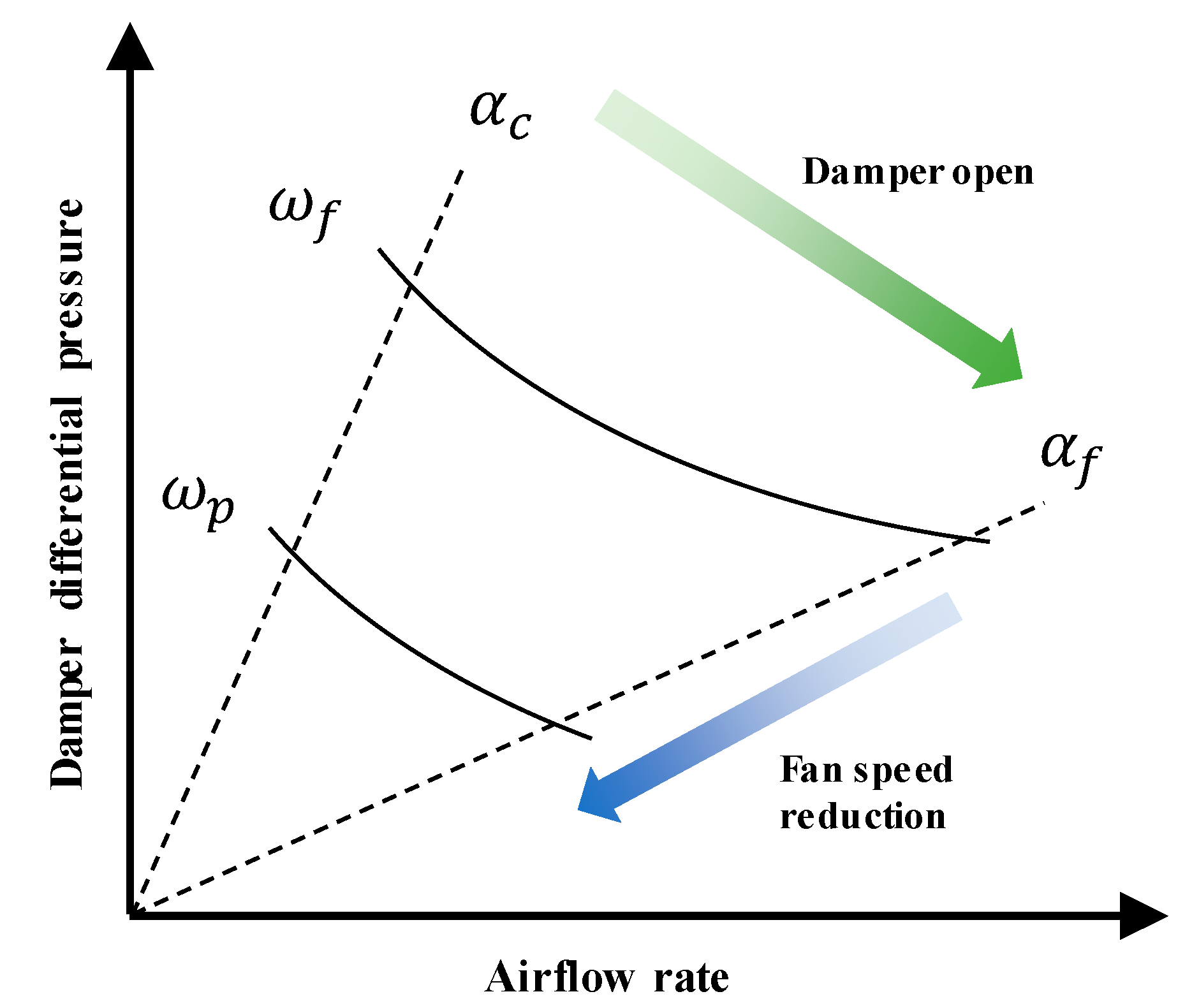
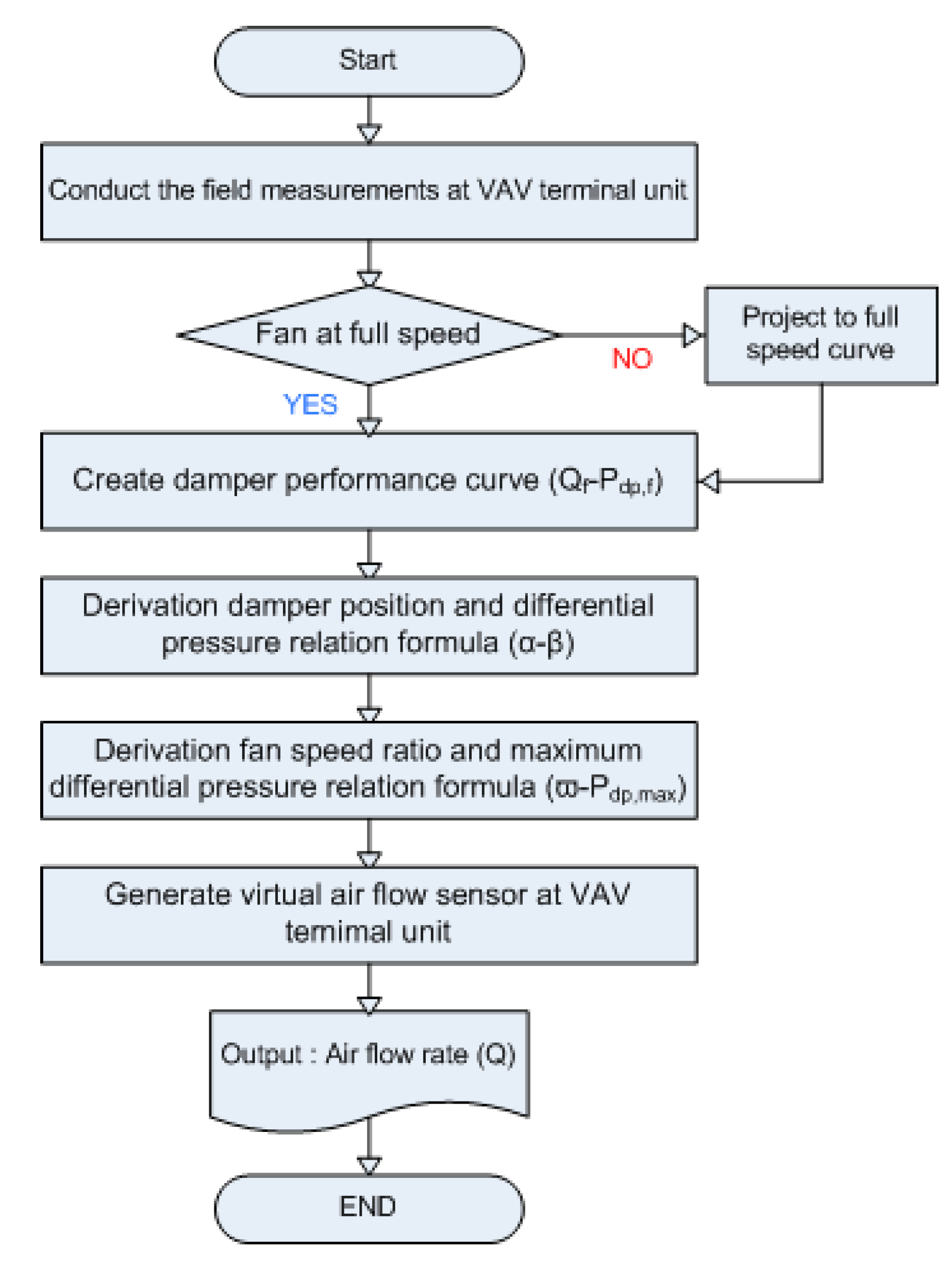
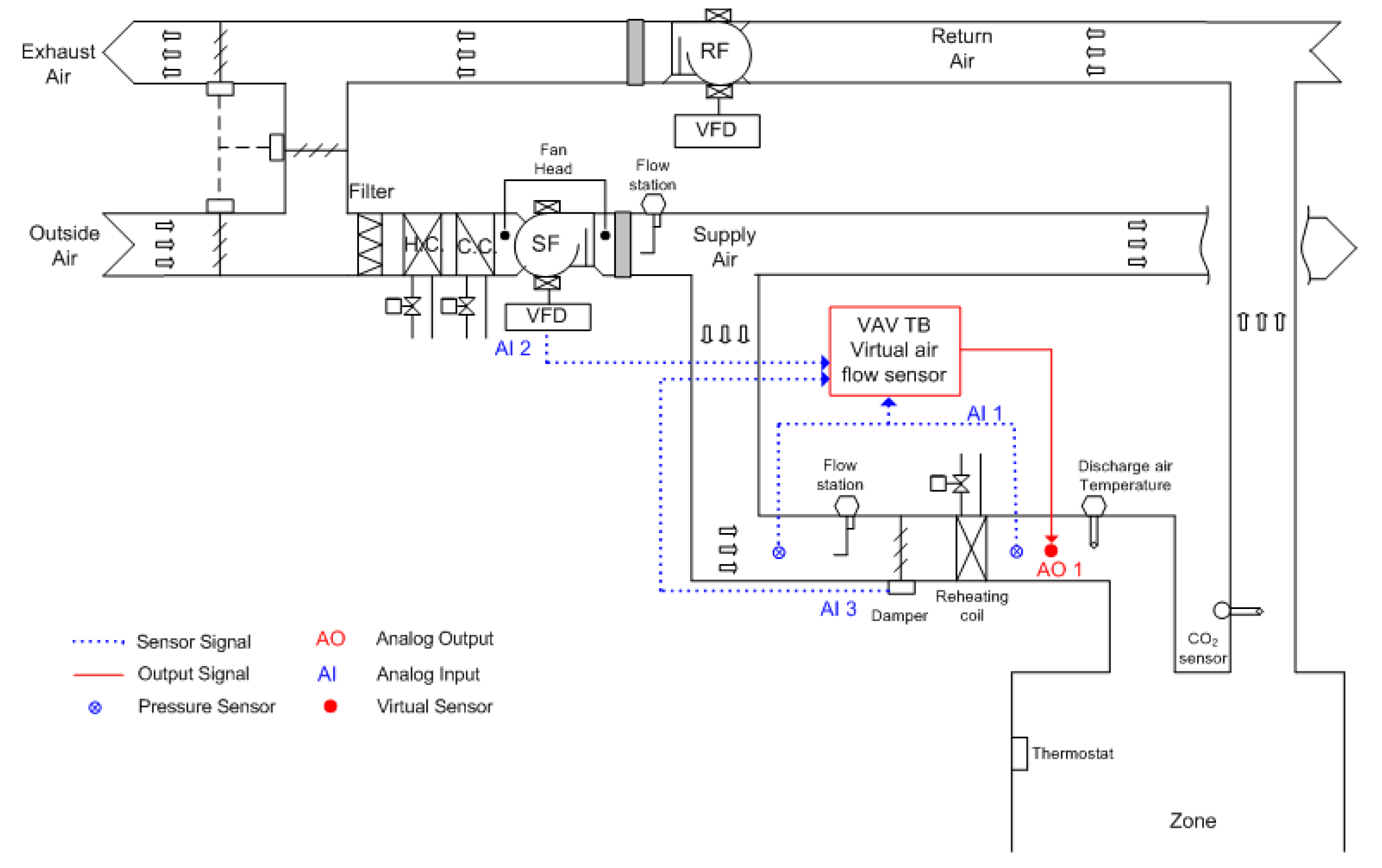
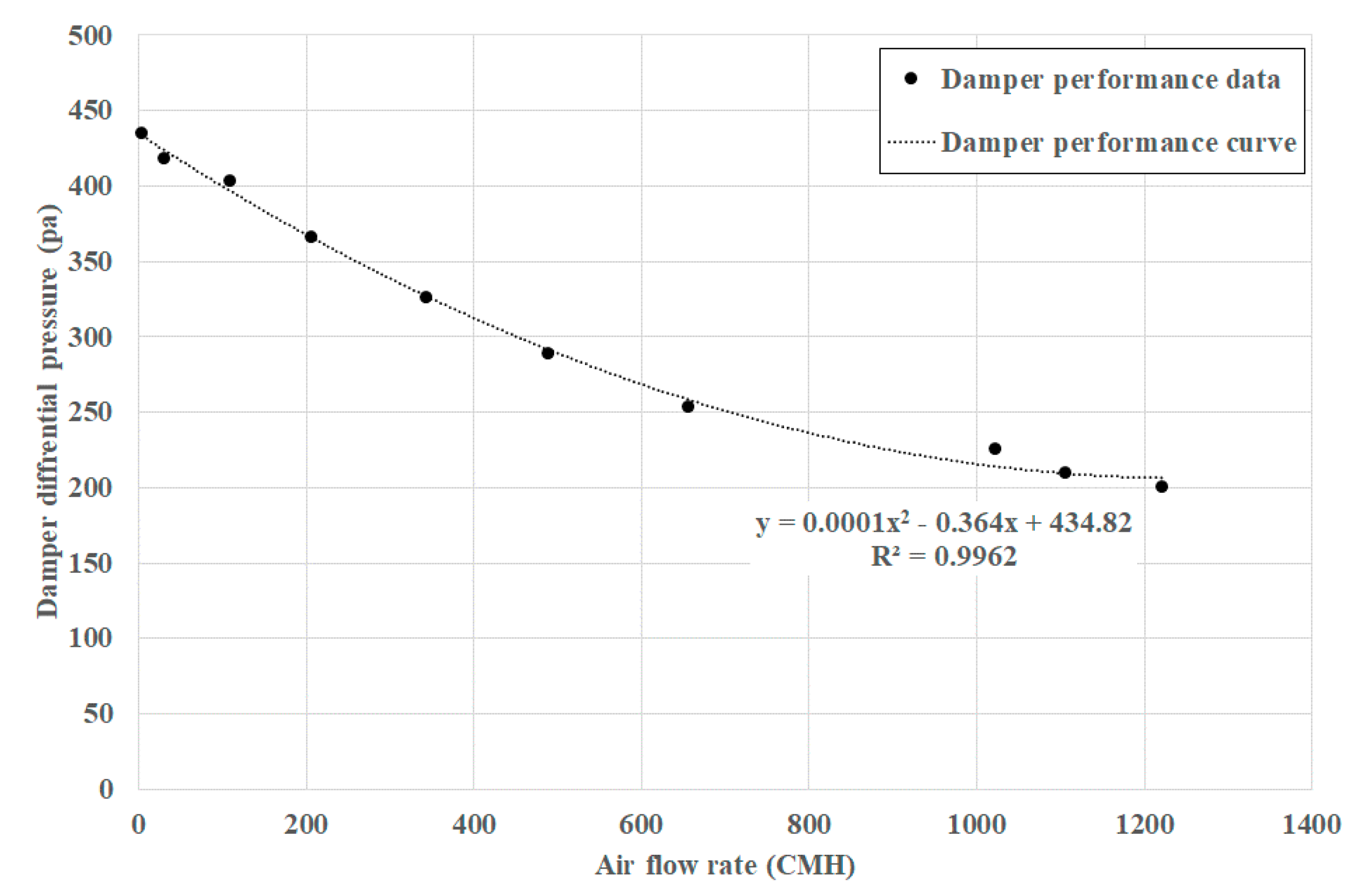
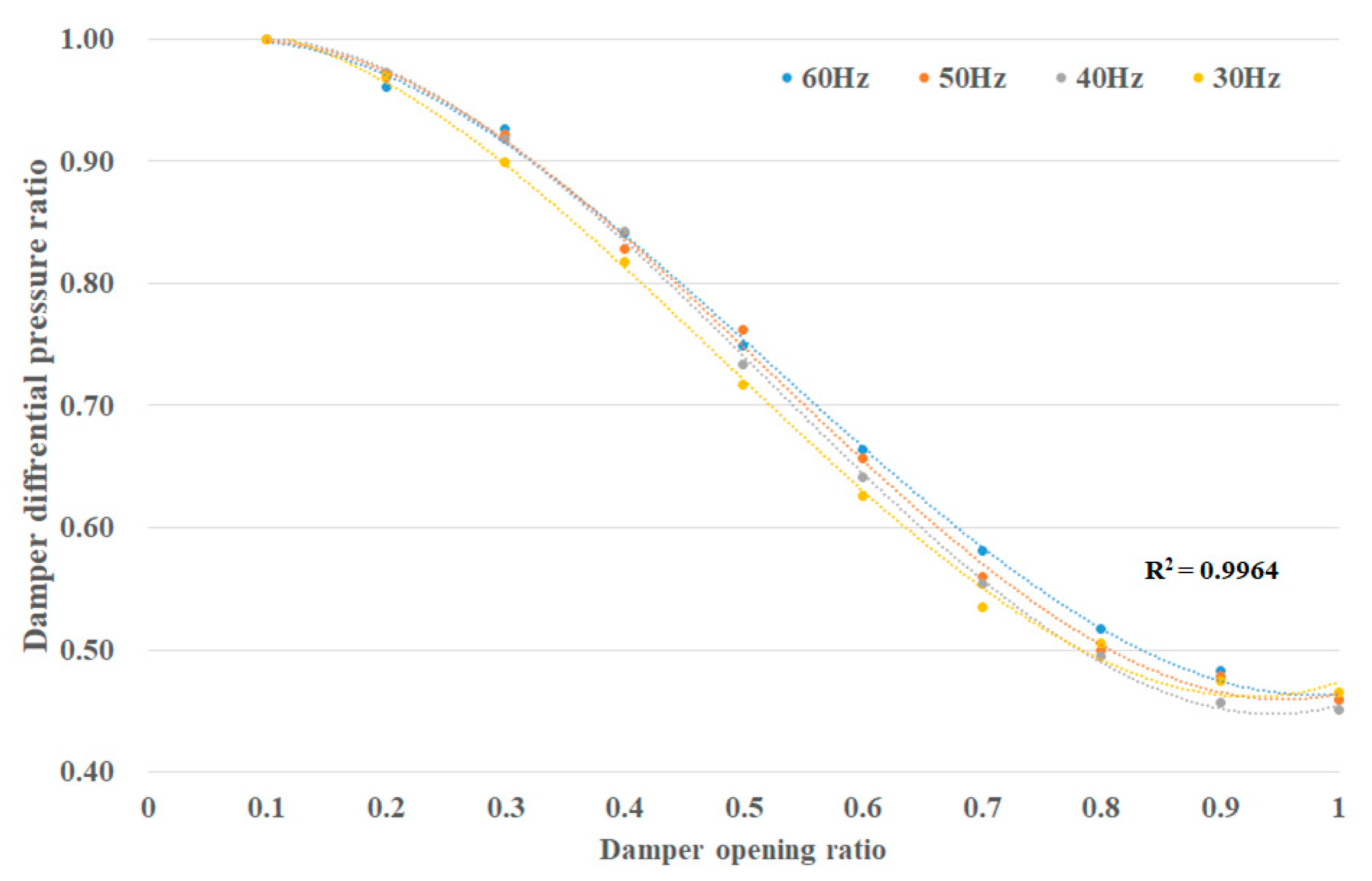
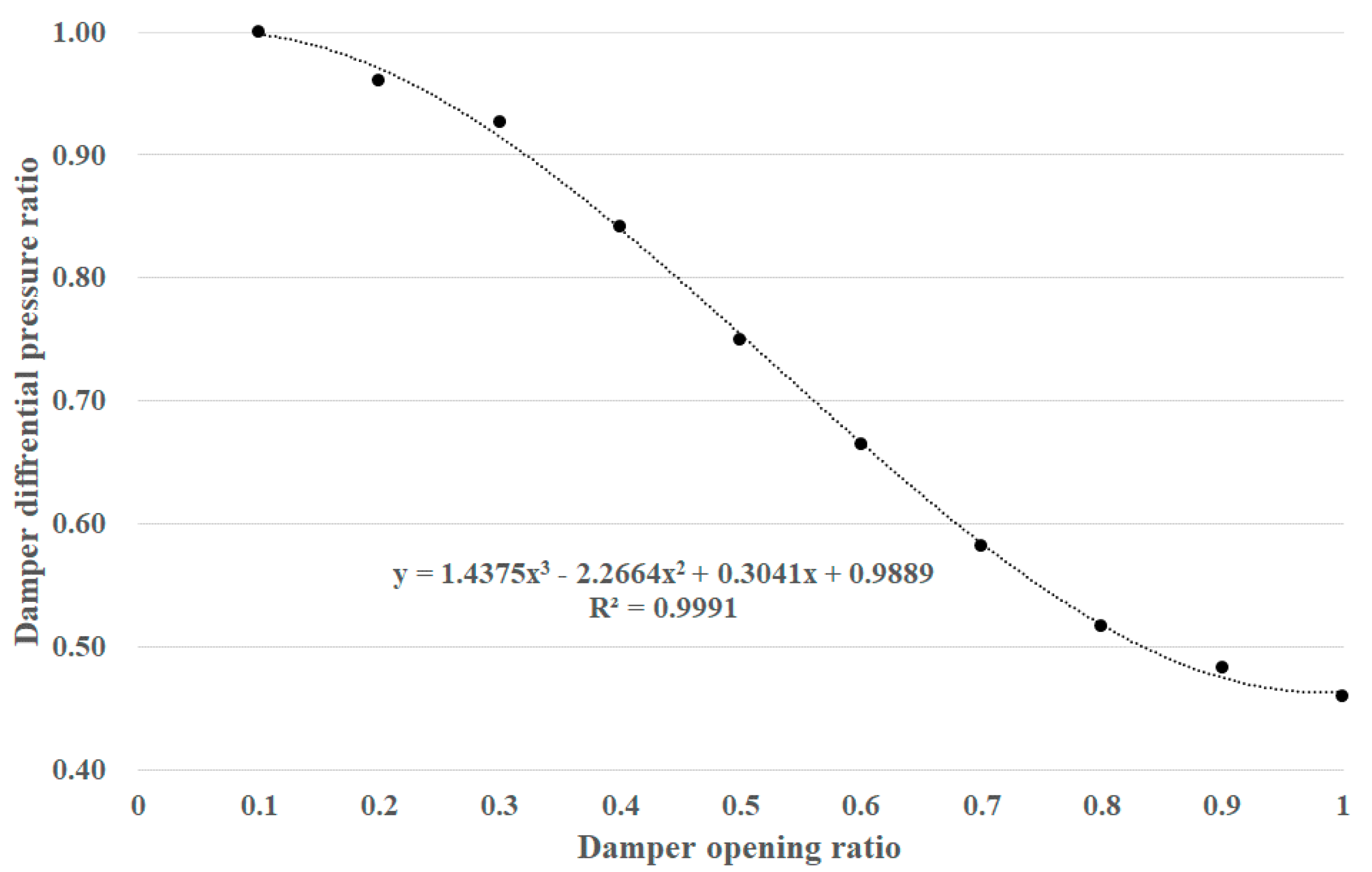
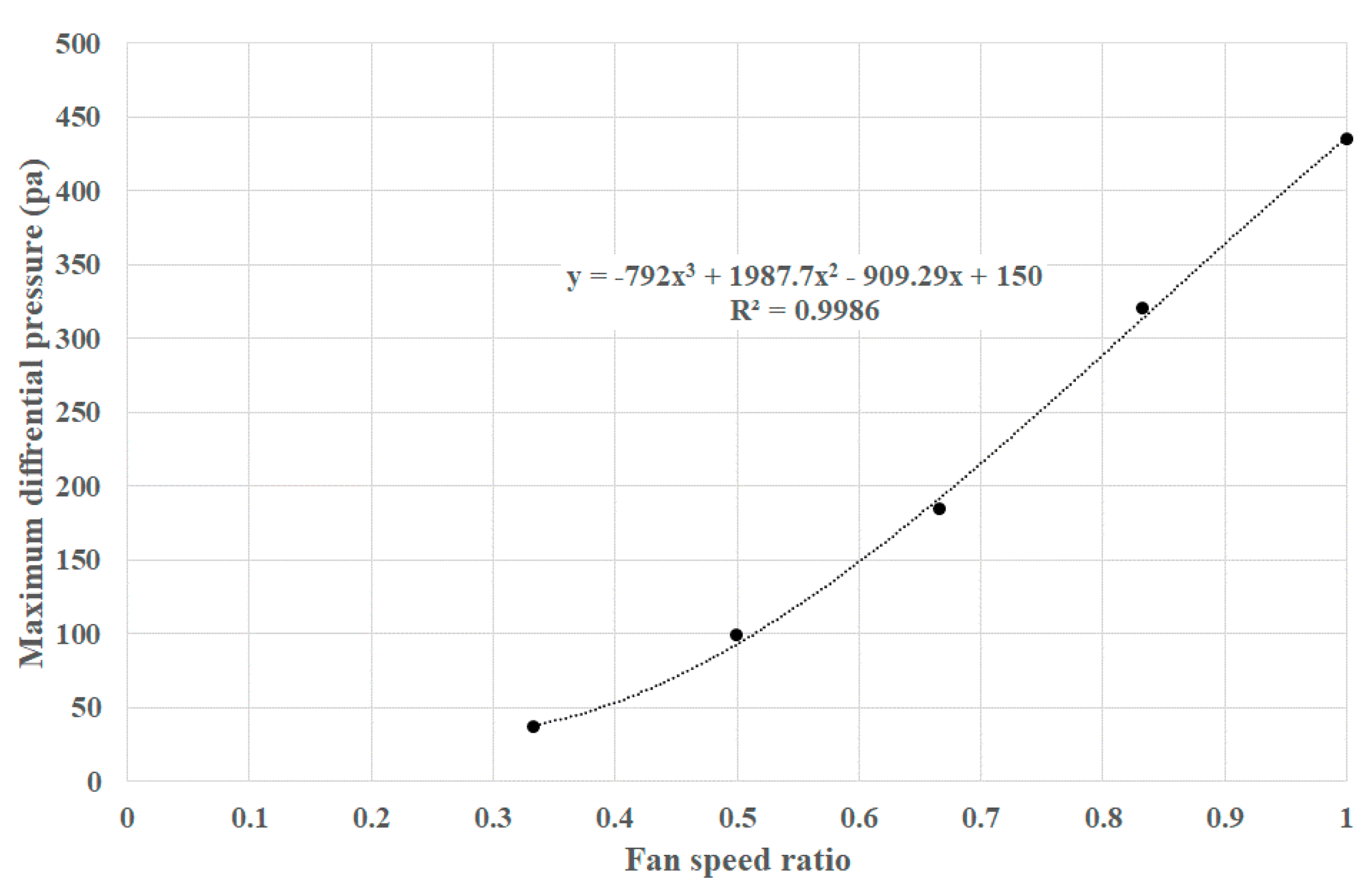
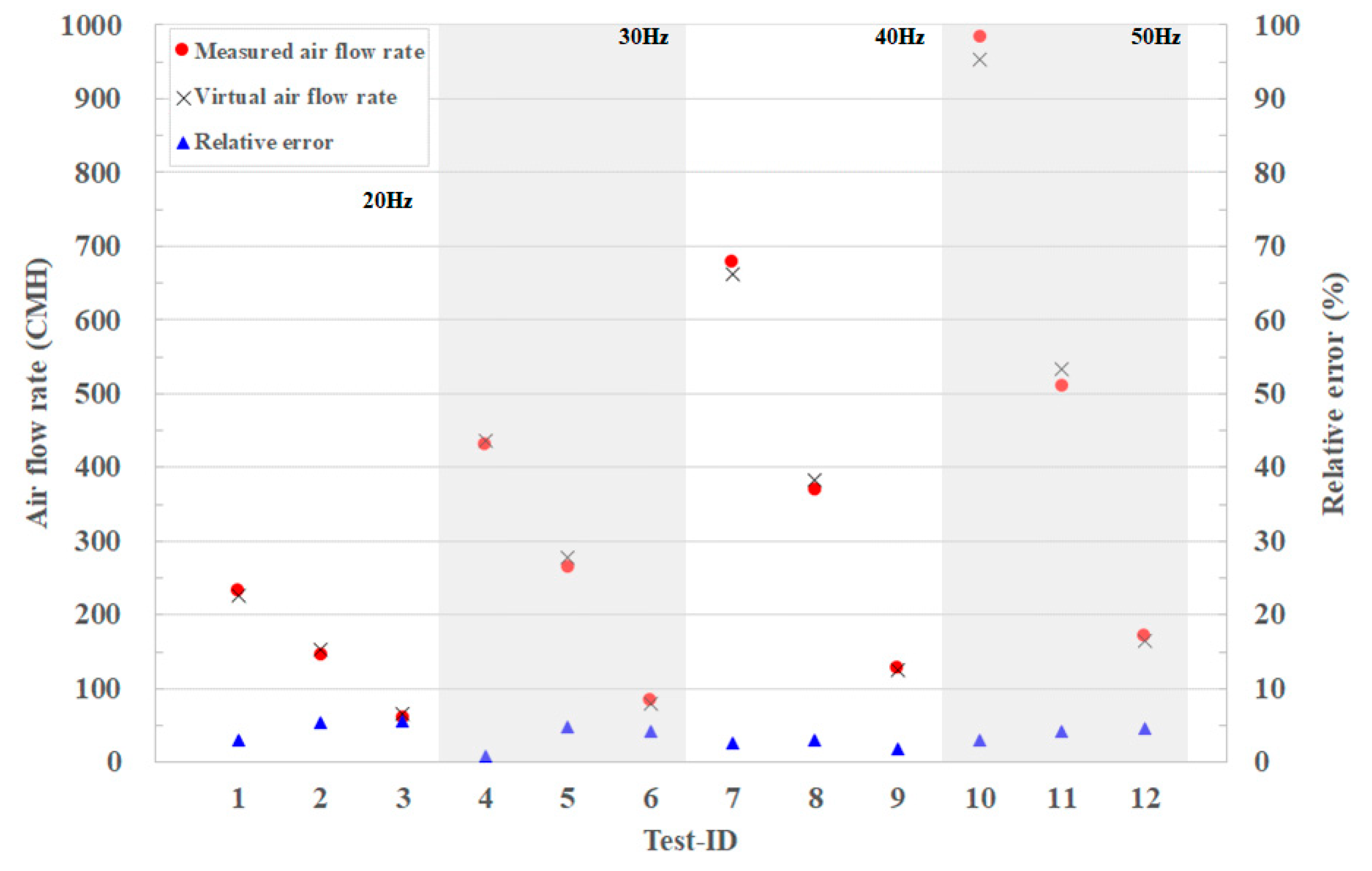
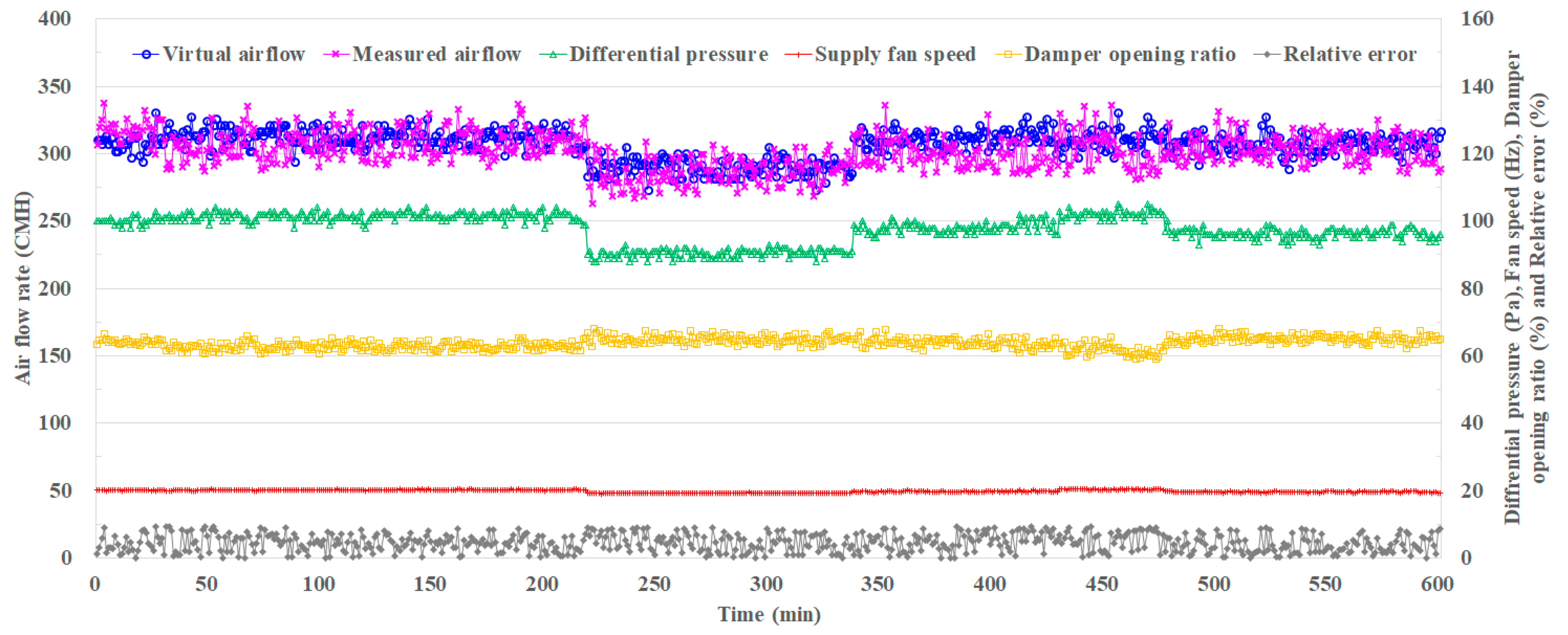
| Errors | Parameters | Symbols | Values | Error Sources | Accuracy | Full Scale |
|---|---|---|---|---|---|---|
| Input | Damper differential pressure | Variable | Error caused by differential pressure transducer to the controller | 1 Pa | 1000 Pa | |
| Input | Supply fan speed | Variable | Output variable from the controller to the VFD | 1 Hz | 60 Hz | |
| Input | Damper opening ratio | Variable | Output variable from the VAV damper actuator | 1% | 100% | |
| Input | Damper performance coefficient | Constant | Propagated error through hot-wire anemometer, damper differential pressure and fan speed when developing damper performance coefficient | - | - | |
| Category | Specification | |||||
|---|---|---|---|---|---|---|
| AHU | Supply Air Fan | Return Air Fan | ||||
| Air Flow (CMH) | Static Pressure (mmAq) | Power (kW) | Air Flow (CMH) | Static Pressure (mmAq) | Power (kW) | |
| 12,000 | 92 | 5.5 | 9600 | 35 | 3.7 | |
| VAV Terminal unit | Rated air flow rate (CMH) | Capacity of reheating coil (kcal) | ||||
| 1360 | 4000 | |||||
| Supply Fan Speed (Hz) | Damper Opening Ratio | Air Flow Rate (CMH) | Damper DP (Pa) |
|---|---|---|---|
| 60 | 1 | 1222 | 200 |
| 0.9 | 1107 | 210 | |
| 0.8 | 1023 | 225 | |
| 0.7 | 657 | 253 | |
| 0.6 | 490 | 289 | |
| 0.5 | 344 | 326 | |
| 0.4 | 207 | 366 | |
| 0.3 | 110 | 403 | |
| 0.2 | 31 | 418 | |
| 0.1 | 4 | 435 |
| Damper Opening Ratio | Supply Fan Speed (Hz) | Air Flow Rate (CMH) | Damper DP (Pa) |
|---|---|---|---|
| 0.1 | 60 | 4 | 435 |
| 50 | 0 | 320 | |
| 40 | 0 | 184 | |
| 30 | 0 | 99 | |
| 20 | 0 | 37 |
| Test-ID | Measured Air Flow Rate (CMH) | Virtual Air Flow Rate (CMH) | Uncertainty (%) | Absolute Error (CMH) | Relative Error (%) | Root mean Square Error (CMH) | Coefficient of Determination |
|---|---|---|---|---|---|---|---|
| 1 | 234 | 227 | ±5.3 | 7 | 3.0 | 13.4 | 0.999 |
| 2 | 146 | 153 | ±6.1 | −8 | 5.4 | ||
| 3 | 62 | 65 | ±8.8 | −3 | 5.6 | ||
| 4 | 432 | 436 | ±0.8 | −3 | 0.8 | ||
| 5 | 265 | 277 | ±1.8 | −13 | 4.8 | ||
| 6 | 84 | 80 | ±3.2 | 4 | 4.2 | ||
| 7 | 679 | 661 | ±0.9 | 18 | 2.6 | ||
| 8 | 370 | 382 | ±2.3 | −11 | 3.1 | ||
| 9 | 128 | 126 | ±5.6 | 2 | 1.8 | ||
| 10 | 983 | 954 | ±1.2 | 29 | 3.0 | ||
| 11 | 512 | 533 | ±2.7 | −22 | 4.3 | ||
| 12 | 172 | 164 | ±7.2 | 8 | 4.7 |
© 2019 by the authors. Licensee MDPI, Basel, Switzerland. This article is an open access article distributed under the terms and conditions of the Creative Commons Attribution (CC BY) license (http://creativecommons.org/licenses/by/4.0/).
Share and Cite
Kim, H.-J.; Jo, J.-H.; Cho, Y.-H. Development of Virtual Air Flow Sensor Using In-Situ Damper Performance Curve in VAV Terminal Unit. Energies 2019, 12, 4307. https://doi.org/10.3390/en12224307
Kim H-J, Jo J-H, Cho Y-H. Development of Virtual Air Flow Sensor Using In-Situ Damper Performance Curve in VAV Terminal Unit. Energies. 2019; 12(22):4307. https://doi.org/10.3390/en12224307
Chicago/Turabian StyleKim, Hyo-Jun, Jae-Hun Jo, and Young-Hum Cho. 2019. "Development of Virtual Air Flow Sensor Using In-Situ Damper Performance Curve in VAV Terminal Unit" Energies 12, no. 22: 4307. https://doi.org/10.3390/en12224307
APA StyleKim, H.-J., Jo, J.-H., & Cho, Y.-H. (2019). Development of Virtual Air Flow Sensor Using In-Situ Damper Performance Curve in VAV Terminal Unit. Energies, 12(22), 4307. https://doi.org/10.3390/en12224307





